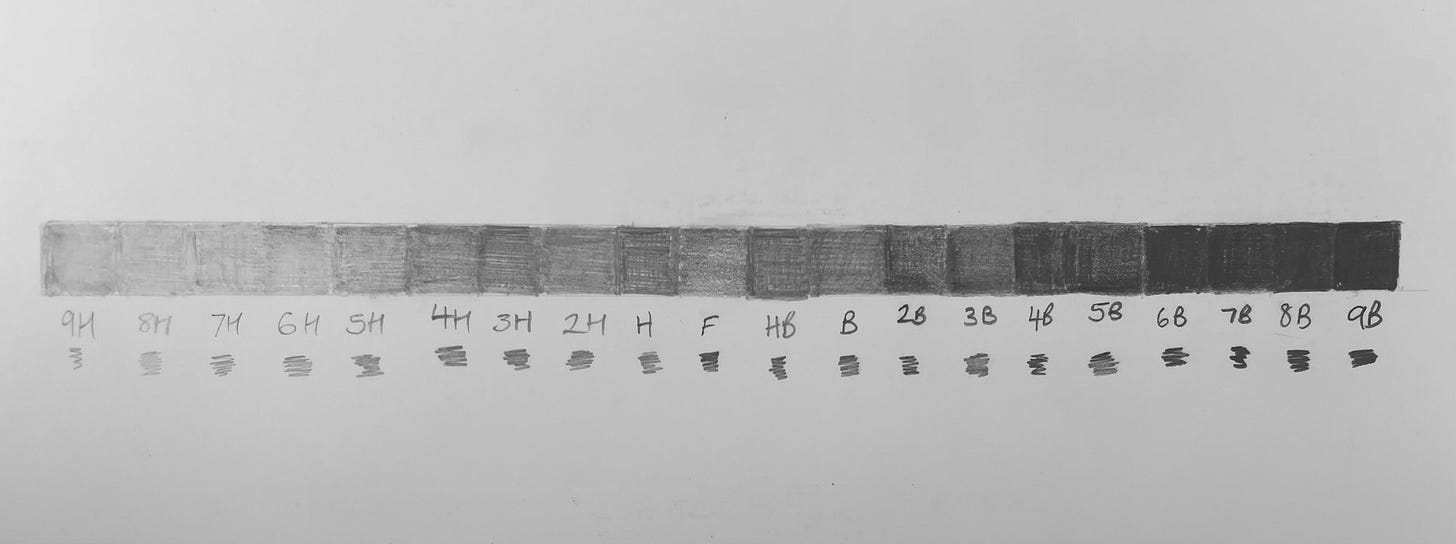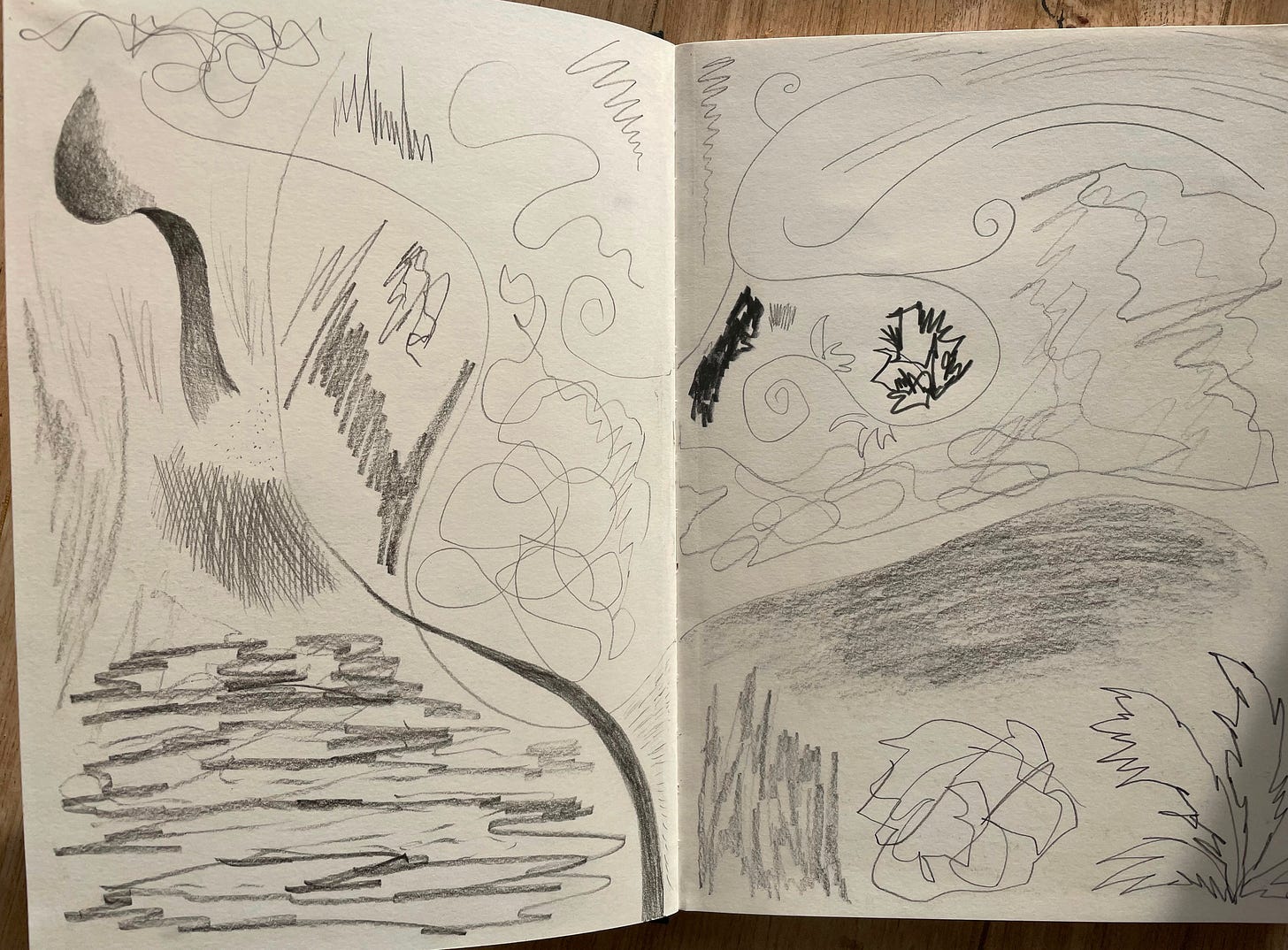Last time
Welcome back! ☺️ So, in the last publication, I spoke about the very basics of drawing tools, surfaces, and exploring mark making either by initutive marks or using artists’ work to inspire you. Let’s move on to the next part…
What did you find?
When you had a sort out, what drawing tools did you find? Or have you been shopping? I am hoping that you may have found some graphite pencils, even if it’s one. I am going to give you the foundations of graphite pencil, so hopefully you can understand the tool better.
The history of a pencil
I have actually discovered through research that there is no such thing as a lead pencil. When a large deposit of graphite was discovered in Borrowdale in England back in 1564, people thought that this was a form of lead as it looked similar. They called in plumbago which means “lead-like.” Later on in history, they discovered that graphite was a form of carbon, but the nickname ‘lead pencil’ stuck and is still use today - I have heard it quite a bit in the art studio. So don’t worry, you haven’t been poisioning yourself for years.
When graphite was discovered back in the 1500s, people used to use it to mark their sheep. Over time the graphite was cut into sticks and wrapped in string or sheepskin for writing - now that’s creative! In the 1700s, wood-cased pencils emerged in Europe and graphite was inserted in between the two wooden halves, mainly cedar, and glued together. In the late 1700s-early 1800s, the pencil was mass produced. Over time, there has been improvements made to the wood and various grades of soft and hard pencils for artists and writers have evolved.
What do the graded pencils mean?
On an artists’ pencil you will discover that there are some characters printed on the wood. It may say something like HB, 2H or 6B. Here is what the letter mean:
H = Hardest
B = Blackest
F = Finest
HB = Middle Ground - Hardest/Blackest
The numbers represent the following:
The higher the number in front of H, the harder and lighter the pencil mark is.
The higher the number in front of B, the softer and darker the pencil mark is.
H pencils are great for light lines and technical drawings. HB and F are balanced and are often used for writing. B pencils are brilliant tools for sketching and shading when drawing pictures.
What is a pencil made of to change the grades?
Nicolas-Jacques Conte developed a method in 1795 of mixing graphite with kaolin clay to control the hardness of the pencil. The clay acts as a binder to give structure to the graphite core. The more clay that is added to the graphite, the harder the pencil is. The more graphite there is, the softer the pencil. A 4H pencil has about 20% graphite and 80% clay, whereas a 4B has about 80% graphite and 20% clay. This is bound together with water to create a paste and then extruded into thin rods, dried and baked in a kiln to harden it. Sometimes it is impregnated with a wax or fat after firing, which improves its smoothness for artists.
There is more to graphite then a wooden pencil!
Graphite can come in many forms: wooden cased pencils, woodless pencils, graphite sticks or crayons, graphite powder, mechanical pencils, graphite blocks or tiles, clutch pencils/lead holders, and water-soluble graphite.
Graphite pencils are in wooden cases and are a common artists’ drawing tool. They are used for detailed line work, shading and sketching.
Mechanical pencils are thin graphite rods that are manually placed inside a plastic or metal cased pencil. The rods usually come in thicknesses between 0.3-0.9mm. They are used for technical and precise drawings, and consistent lines. The rods are replaceable.
Graphite sticks or crayons are heavier to hold and they are often quite chunky. These are great to use for larger, broad and expressive strokes and textural work.
Woodless graphite pencils are made entirely of graphite coated in a lacquer. They allow the artist to use the side of the pencil for shading.
Graphite powder is loose powdered graphite that can be applied with fingers, brushes, cotton buds or tissues. It creates smooth gradients and shadows. It can be used for large-scale work or for mixed media art.
Water-soluble graphite reacts with water. It can be used dry like a pencil or used wet like a watercolour. It adds a paint-type effect and washes to the drawing.
Clutch pencils / lead holders hold thick graphite rodes between 2-5.6mm. They are great for fine and bold lines and the rods are replaceable.
Graphite blocks or tiles are large flat pieces of compressed graphite and are great to use for gestual drawings, abstract form or life drawings.
Artists will have their favourite brands and type of pencil. Personally, I like Faber-Castell wooden cased pencils and I also have a couple of mechanical pencils for precision drawings.
Have a play
Whatever graphite you have at home, have a play around with them. Explore the hardness and softness of the grades, the pressures of the pencils, hold them in different ways, and use your hands, wrists, elbows and shoulders to discover what marks you make using different scales. If you have the less common graphite like powder, crayons and blocks, discover how they work and see what you prefer to use. You may discover you like big, gestual marks using the chunky, graphite sticks or precise patterns and lines using a mechanical pencil.
I will leave you for now and I’ll see you again for the next Foundations to Flourish.
I will be massively overjoyed if you let me know how you get on in the comments. I love it when a comment pops through on my phone….it means I get to talk about art! ☺️
Enjoy creating,







Thank you so much for this series, Nicki - I’ve found it so clear & inspiring! Looking forward to putting more into practice xx
I’m not usually drawn to (!) stippling but I found this inspiring! Thank you Nicki X